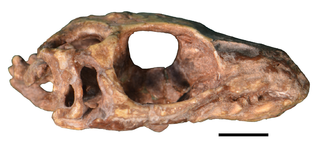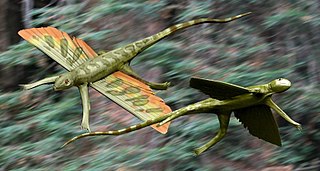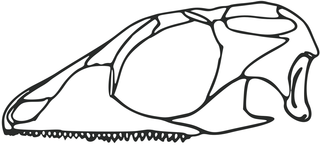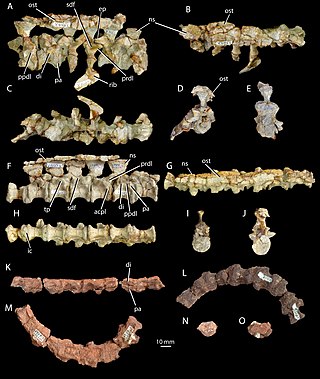Susan Elizabeth Evans is British palaeontologist and herpetologist. She is the author or co-author of over 100 peer-reviewed papers and book chapters. [1]
She received a BSc in Zoology at Bedford College in 1974, and in 1977 a PhD in vertebrate palaeontology from the University College London. In 1980 she was Assistant Professor in biology at the University College of Bahrain and went continued as a lecturer in Anatomy at Middlesex Hospital Medical School. She was also Senior Lecturer with the Department of Anatomy and Developmental Biology at the University College, London [2] In 2003, she became a Professor of Vertebrate Morphology and Palaeontology at University College London.
Her research focuses on the evolution of key morphological features in lizards, amphibians and their extinct relatives. [3] In particular the research focuses on the implications of the above with regards to macroevolution, phylogenetic relationships, function, palaeoecology, and biogeography. [4] Along with Michael Benton and Jacques Gauthier, she was one of the pioneers of applying cladistic methodology to reptile (especially Lepidosaurian) evolutionary relationships. [5]
Beginning in 2001, Dr Evans became involved in the Mahajanga Basin Project which was conducted jointly with the University of Antananarivo. In investigating the Maevarano Formation, the researchers established Madagascar as having some of the most complete and scientifically significant fossils of Late Cretaceous vertebrates in the southern hemisphere. [6] Along with her colleague Marc E. H. Jones, Evans worked on the evolutionary relationships of the giant prehistoric frog Beelzebufo ampinga that was discovered by Dr David Krause of Stony Brook University. [7] [8] [9]
Professor Evans is a Fellow of the Linnean Society and a Scientific Fellow of the Zoological Society. Her research has also been supported by the Royal Society, The Leverhulme Trust, the National Geographic Society, and the Biotechnology and Biological Sciences Research Council. [1]
In 2008, a newly described Eocene Agamid lizard Vastanagama susani was named in her honour. [10] The squamatan clade "Evansauria" has also been named after her. [11] In 2024, Martin-Silverstone et al. named the darwinopteran pterosaur species Ceoptera evansae after her. [12]

An anapsid is an amniote whose skull lacks one or more skull openings near the temples. Traditionally, the Anapsida are the most primitive subclass of amniotes, the ancestral stock from which Synapsida and Diapsida evolved, making anapsids paraphyletic. It is however doubtful that all anapsids lack temporal fenestra as a primitive trait, and that all the groups traditionally seen as anapsids truly lacked fenestra.

The Lepidosauria is a subclass or superorder of reptiles, containing the orders Squamata and Rhynchocephalia. Squamata includes lizards and snakes. Squamata contains over 9,000 species, making it by far the most species-rich and diverse order of non-avian reptiles in the present day. Rhynchocephalia was a formerly widespread and diverse group of reptiles in the Mesozoic Era. However, it is represented by only one living species: the tuatara, a superficially lizard-like reptile native to New Zealand.

Rhynchocephalia is an order of lizard-like reptiles that includes only one living species, the tuatara of New Zealand. Despite its current lack of diversity, during the Mesozoic rhynchocephalians were a speciose group with high morphological and ecological diversity. The oldest record of the group is dated to the Middle Triassic around 238 to 240 million years ago, and they had achieved a worldwide distribution by the Early Jurassic. Most rhynchocephalians belong to the group Sphenodontia ('wedge-teeth'). Their closest living relatives are lizards and snakes in the order Squamata, with the two orders being grouped together in the superorder Lepidosauria.

Lepidosauromorpha is a group of reptiles comprising all diapsids closer to lizards than to archosaurs. The only living sub-group is the Lepidosauria, which contains two subdivisions, Squamata, which contains lizards and snakes, and Rhynchocephalia, the only extant species of which is the tuatara.

Drepanosaurs are a group of extinct reptiles that lived between the Carnian and Rhaetian stages of the late Triassic Period, approximately between 230 and 210 million years ago. The various species of drepanosaurid were characterized by specialized grasping limbs and often prehensile tails, adaptions for arboreal (tree-dwelling) and fossorial (digging) lifestyles, with some having also been suggested to be aquatic. Fossils of drepanosaurs have been found in Arizona, New Mexico, New Jersey, Utah, England, and northern Italy. The name is taken from the family's namesake genus Drepanosaurus, which means "sickle lizard," a reference to their strongly curved claws.

The Museum of Evolution of Polish Academy of Sciences is the display area of the natural history museum in Warsaw, Poland. It is the public front of the Muzeum i Instytut Zoologii or Zoology Museum and the Instytut Paleobiologii or Paleobiology Institute. It is based at the Palace of Culture and Science.

Osmolskina is a genus of archosauriform reptile which lived during the Early Triassic in what is now Poland. The type species, Osmolskina czatkowicensis, was described by Magdalena Borsuk−Białynicka and Susan Evans in 2003. The generic name honors the late female Polish paleontologist Halszka Osmólska.

Eolacertilia is an extinct clade of lepidosauriform diapsid reptiles known from the Late Permian to the Late Triassic. It is uncertain as to whether they are a natural group and it has been suggested that they form a "waste basket" taxon. Currently, the only members of the group are Paliguana and Kuehneosauridae. Other genera were transferred to basal groups within Diapsida, Archosauromorpha.

Paleontology or palaeontology is the study of prehistoric life forms on Earth through the examination of plant and animal fossils. This includes the study of body fossils, tracks (ichnites), burrows, cast-off parts, fossilised feces (coprolites), palynomorphs and chemical residues. Because humans have encountered fossils for millennia, paleontology has a long history both before and after becoming formalized as a science. This article records significant discoveries and events related to paleontology that occurred or were published in the year 2009.
Czatkobatrachus is an extinct genus of Early Triassic (Olenekian) salientian amphibians. It was first described in 1998 based on fossils found in the Czatkowice 1 quarry in Poland. It is, with Triadobatrachus, one of the two oldest known lissamphibians. More precisely, it is a member of Salientia; it is related to, but outside Anura, the taxon that includes all extant frogs. It is known only from the early Triassic of Poland. Its vertebral column may have been short as in other salientians, but the exact count is unknown. It had a short tail, and an elongated ilium.

Kuehneosauridae is an extinct family of small, lizard-like gliding diapsids known from the Triassic period of Europe and North America.

Gephyrosaurus is a genus of early rhynchocephalian first described and named in 1980 by Susan E. Evans. They are distantly related to the extant Sphenodon with which they shared a number of skeletal features including a large tooth row along the side of the palatine bone and posterior process of the dentary bone. The type species, G. bridensis, lived during Early Jurassic in Wales, UK. Whiteside & Duffin (2017) described the second species, G. evansae, known from a partial maxilla recovered from Late Triassic (Rhaetian) fissure fills in Carboniferous Limestone in Somerset. Gephyrosaurus, other potential gephyrosaurids and Wirtembergia are the only rhynchocephalians to lie outside Sphenodontia in modern definitions of the group, and have been found to be more closely related to squamates in some phylogenetic analyses.

Sophineta is an extinct genus of basal lepidosauromorph reptile known from the Early Triassic of Małopolska Province, southern Poland. It contains a single species, Sophineta cracoviensis.
Czatkowiella is an extinct genus of long-necked archosauromorph known from Early Triassic rocks of Czatkowice 1, Poland. It was first named by Magdalena Borsuk−Białynicka and Susan E. Evans in 2009 and the type species is Czatkowiella harae.

Halazhaisuchus is an extinct genus of archosauriform from the Early Triassic of China. It is known from a single species, Halazhaisuchus qiaoensis, which was named in 1982 from the lower Ermaying Formation in Shaanxi. It was assigned to the family Euparkeriidae as a close relative of the genus Euparkeria from South Africa. Halazhaisuchus is known from a single holotype specimen called V6027, which was discovered in 1977 and includes a portion of the vertebral column, some ribs, two scapulae and two humeri, the right radius and ulna, and a left coracoid. Two rows of plate-like bones called osteoderms run along the length of the vertebrae. When it was first described in 1982, Halazhaisuchus was considered a close relative of Euparkeria because it has primitive features like small intercentra bones between the vertebrae and a large coracoid, not seen in later archosaurs. However, these features are common to many early archosauriforms and are not unique to Euparkeriidae.

Protorosauria is an extinct, likely paraphyletic group of basal archosauromorph reptiles from the latest Middle Permian to the end of the Late Triassic of Asia, Europe and North America. It was named by the English anatomist and paleontologist Thomas Henry Huxley in 1871 as an order, originally to solely contain Protorosaurus. Other names which were once considered equivalent to Protorosauria include Prolacertiformes and Prolacertilia.

Marmoretta is an extinct genus of small lepidosauromorph reptile known from the Middle Jurassic (Bathonian) of Britain, as well as the Late Jurassic of Portugal. It contains a single species, Marmoretta oxoniensis.

Megachirella is an extinct genus of lepidosaur, possibly a stem-squamate that lived about 240 million years ago during the Middle Triassic and contains only one known species, Megachirella wachtleri. It is known from a partial skeleton discovered in the Dolomites of Northern Italy and was described in 2003.
Pleurodontagama is an extinct genus of iguanian lizard from the Late Cretaceous of Mongolia. The type species, Pleurodontagama aenigmatodes, was named in 1984 on the basis of a mostly complete skull and isolated lower jaw from a fossil locality called Khermeen Tsav. It has a wide skull with a flat snout, large eye sockets, and small bumps on the surfaces of the bones. Pleurodontagama was initially classified in the family Priscagamidae, which is usually grouped in a large clade of iguanians called Acrodonta, members of which are characterized by an "acrodont" dentition in which the teeth grow from the margins of the jaws. However, Pleurodontagama is unusual in that it has a sub-pleurodont dentition, meaning that some of its teeth grow from the inner surfaces of the jaw. There is also evidence to suggest that its teeth may have been continuously replaced throughout life, as opposed to the permanent teeth of acrodontans. Pleurodontagama may have been a transitional form between the derived acrodont type and the pleurodont type inferred for the ancestors of Acrodonta.
Fraxinisaura is an extinct genus of basal lepidosauromorph reptile known from the Middle Triassic of Germany. The only known species is Fraxinisaura rozynekae. It possessed an elongated snout, unique features of the teeth, and an ilium which was intermediate in orientation between sphenodontians and squamates. Based on characteristics of the maxilla, it is considered a close relative of Marmoretta from the Middle Jurassic of the United Kingdom, resolving a ghost lineage between that genus and other Triassic basal lepidosauromorphs.